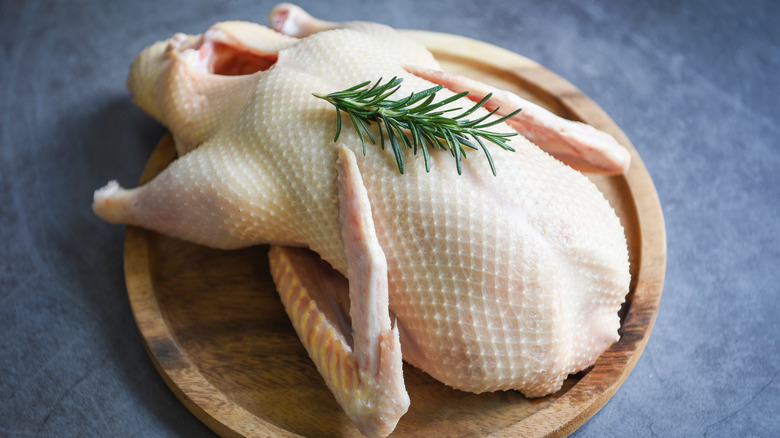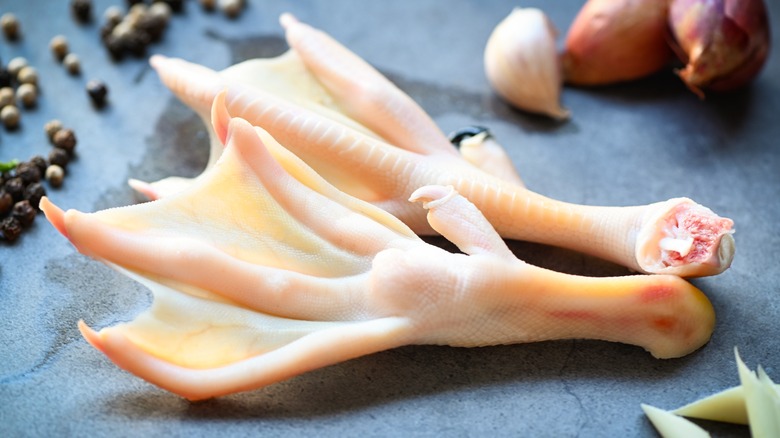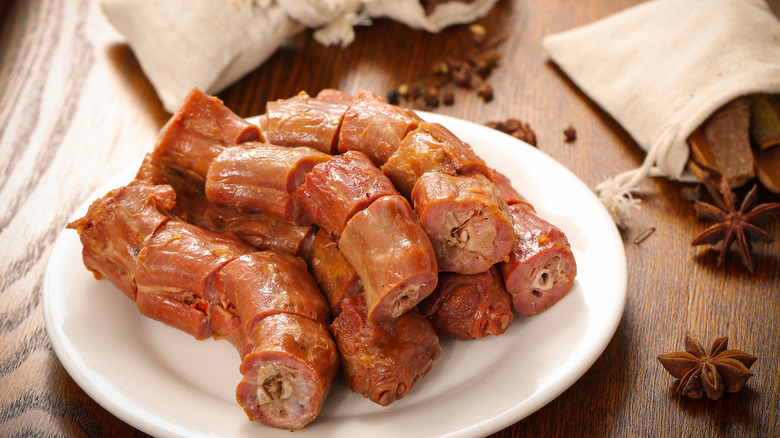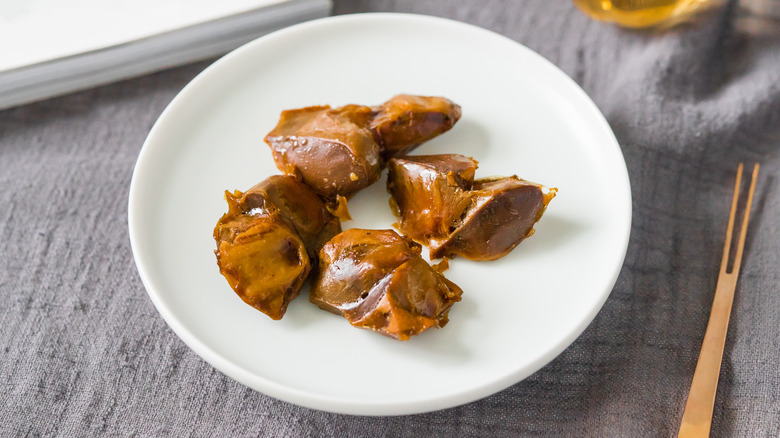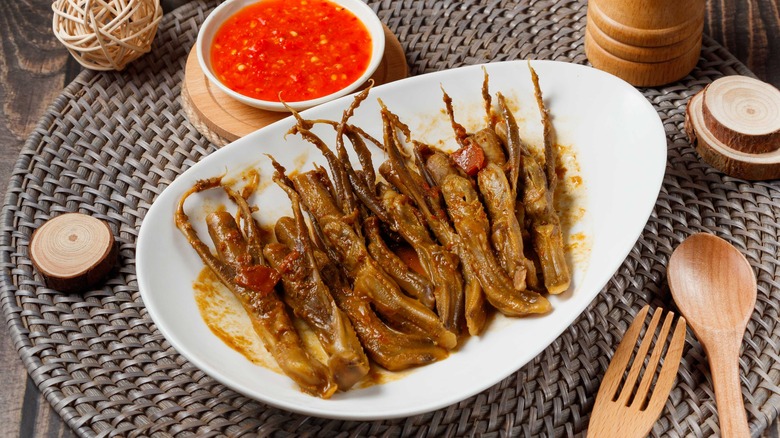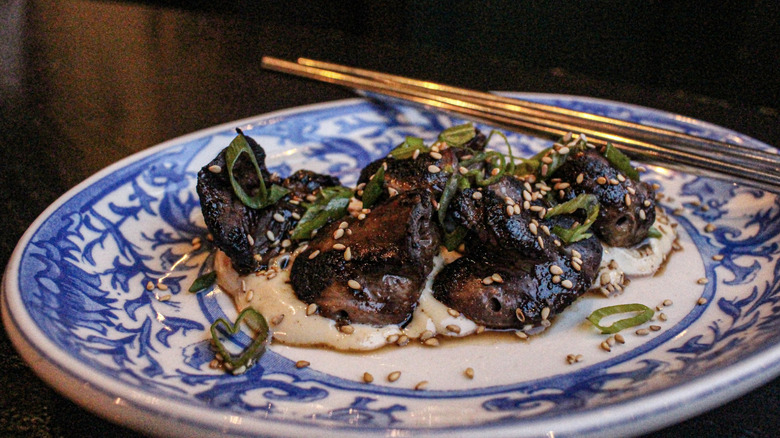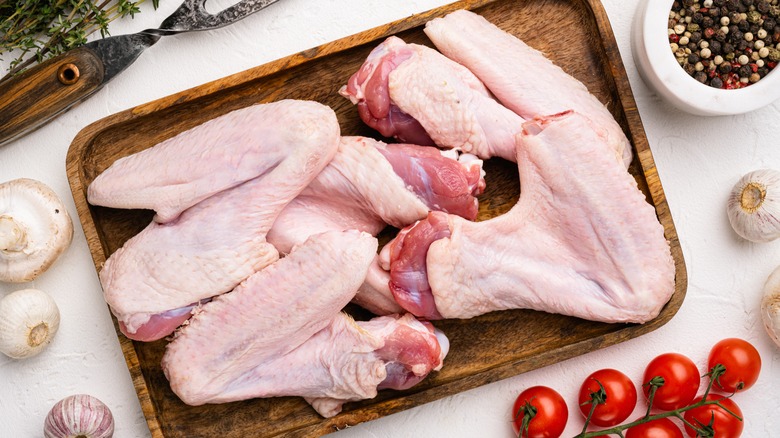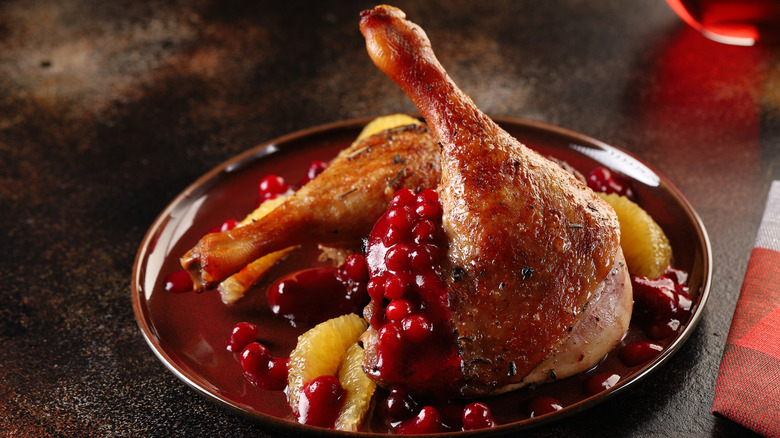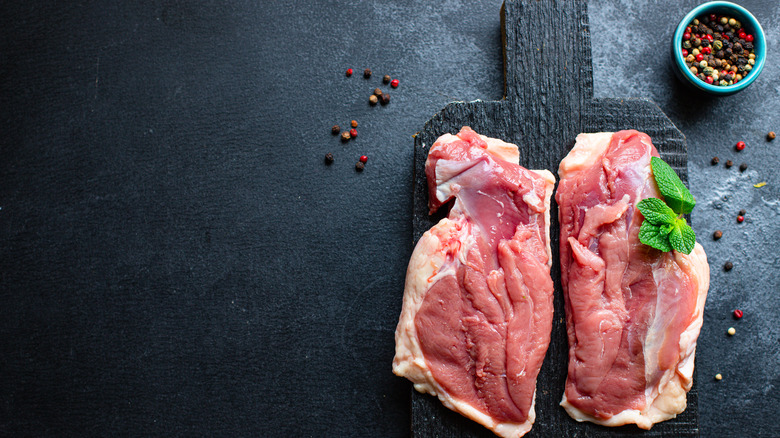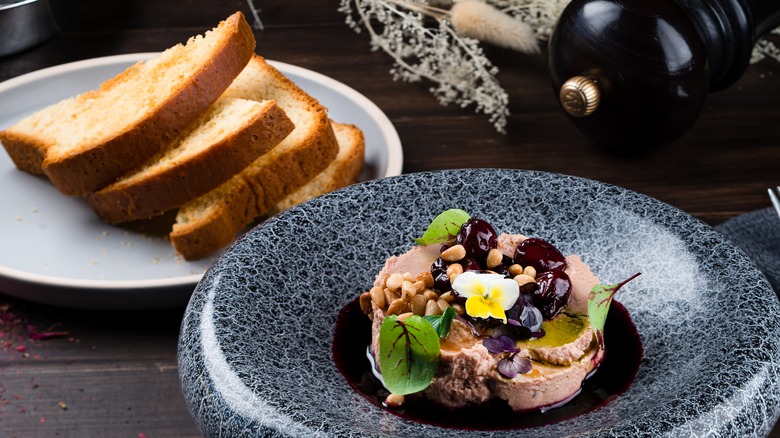Ranking Cuts Of Duck, From Worst To Best
Duck meat is a delicious and healthy alternative to both red meat and other poultry such as chicken or turkey. It's leaner and contains fewer calories than other fowl meat, yet is packed with good stuff like protein and iron, as Maple Leaf Farms highlights. Somewhere between white and dark meat, duck is also a very versatile meat. While you can cook the entire duck (usually after removing the head and giblets), it can also be easily divided into different cuts that can be utilized in a variety of ways.
While the breast cut is usually the most popular part of the duck in cooking, the hearty flavor of duck thighs and legs makes them great for mini roasts, braising, and casseroling. Often overlooked, duck wings and offal are also valuable in cooking. Just like duck thighs and legs, duck wigs can be easily turned into a flavorful dish. Meanwhile, offal, such as duck necks and hearts, can be pan-fried or used to enhance the flavor of stocks and broths.
Ready to incorporate duck in your culinary adventures? Take a look at our ranking of duck cuts, from worst to best.
Duck feet
While duck feet aren't usually used in cooking in Western cultures, they have a prominent role in some culinary traditions. More specifically, duck feet are commonly utilized in Chinese to make soups and broths. Since duck feet contain cartilage, just like chicken feet, they produce a lot of gelatin during cooking, which makes them perfect for making stock. Duck stock, in turn, makes a great addition to risottos, stews, and ragus. Eaten on their own, duck feet can be chewy since they contain bones and connective tissues. This is why they are often braised with spices and sauces in Chinese cuisine.
Reddit users have their own culinary duck feet recommendations. One writer points out that duck feet are different from chicken feet, saying, "They are webbed. This means that there is more 'meat' than on chicken feet (it's actually more skin/cartilage/whatever). Try looking up Chinese recipes for duck feet." Another user recommends using duck feet to make stock, adding, "I don't tend to be super adventurous, but I tossed my (scalded and peeled) duck feet, wings, and spines in 'stock packs' in the freezer for when I get around to making duck stock."
Duck necks
Duck necks aren't typically eaten in some parts of the world because they tend to be tough and laden with connective tissue. And while flavorful, just like duck feet, duck necks have very little meat. As such, they are commonly used to make stock or sauces rather than eaten on their own. This being said, they are very popular in China, where they are often cooked at different levels of spiciness, cut into 2-inch pieces, and served in a bag.
Greg Hunter from The Gutter describes the experience of tasting duck necks as eating something akin to a potato chip. He elaborates that the cut was both chewy and crunchy in texture (if that's possible) with no taste. After trying a spicy take on the dish in China, Hunter still seems unimpressed, saying that the snack had a stringy outer layer and was bony on the inside. Not everybody agrees, however, since the internet abounds with recipes for the duck necks with some calling them "tasty and flavorful" and "lean and tender."
Duck gizzards
A part of the duck's digestive system, duck gizzards are tasked with breaking down food. The small, muscular organs are circular in shape and encased in a membrane. When incorporated in cooking, they feature a distinct texture and gamey flavor, and are a popular ingredient in many cuisines, where they are commonly used to make stews, soups, and sauces. They are also often fried, grilled, steamed, and sauteed. Hank Shaw from Honest Food recommends slow cooking gizzards, highlighting that he frequently corns them — corned beef-style — and cooks them for the entire day, making for a "magical, mystical dish."
While some may find the idea of eating duck gizzards unappetizing, they are jam-packed with essential nutrients. In fact, the gizzard is one of the healthiest organ meats around. According to Eating Expired, gizzards aren't just low in fat, but also high in iron and zinc. They also contain niacin, vitamin B12, and riboflavin. This being said, gizzards have a high cholesterol content and, as such, should be eaten in moderation.
Duck tongues
If you've ever seen an angry duck, you'll be more than familiar with duck tongues. When crossed, the birds often stick out their tongues to make themselves look intimidating. As important as duck tongues may be in the avian culture, many still don't know that the organ is also commonly used in cooking — well, depending on the part of the world you're located. In China, for example, it's common to see restaurants serve deep-fried or braised duck tongues.
Unlike some other duck organs that should be slow cooked, duck tongues are easy to prepare. All you need is a bit of frying oil and seasoning. When it comes to the dining experience, duck tongues contain a fair amount of fat and very little meat. There's also a bone that can be either removed or savored as a crunchy addition to your exotic snack.
For such little morsels, duck tongues are surprisingly good for you. Jam-packed with zinc, choline, iron, and vitamin B12, as well as fatty acids, tongue meat has been recommended for pregnant women and people recuperating after an illness (via Exotic Meat Markets).
Duck hearts
A part of a duck's cardiovascular system, hearts do their fair share of hard work to keep the body running — or in this case, flying — which turns them into lean and flavorful pieces of meat. Harvest Your Own highlights that while they are often overlooked in favor of other waterfowl cuts, hearts are a delicious protein. The platform recommends broiling the offal prior to grilling to remove any excess blood and add flavor. It also notes that duck hearts can be easily smoked, frozen, or even canned.
Cara Nicoletti from Food52 calls duck hearts a "gateway offal" since, according to her, they aren't as exotic — or foreign to our sensibilities — as some other poultry cuts. According to Nicoletti, duck hearts are very similar to duck breasts, without the hefty price tag. For best results, she recommends marinating the hearts in garlic and herbs or soy and ginger overnight, skewering and seasoning them, and grilling them on high heat.
Duck wings and drummettes
A delicious alternative to chicken wings, duck wings are known for their rich, savory flavor and succulent texture. The Capital Journal speaks favorably of duck wings, saying that they are more flavorful than their chicken counterparts, which are merely a "vehicle for other stuff." Instead, the more gamey flavor of duck wings is only accentuated by other ingredients. As such, duck wings should come with sauces that only enhance their flavor rather than overpower it.
Passionate Foodie agrees, lamenting the fact that unlike chicken wings, duck wings aren't generally served at restaurants. While they may have less meat and may be a little trickier to prepare, duck wings come with a wonderfully crispy skin and delicious flavor that's both satisfying and memorable.
Duck wings are usually fried, roasted or grilled and served with sides. Whatever the cooking method, many chefs opt to marinate the poultry in a rub or a sauce to tenderize the meat. This is because duck wings tend to be tougher than chicken wings due to the fact that ducks fly, which translates to firmer muscles in their wings. Instead of being served whole, duck drumettes — which are a segment of the wing — are typically used to make cofits and cassoulets.
Duck legs and thighs
Duck legs and thighs (they are usually not separated) tend to be darker and richer in flavor than duck breast. In fact, chef Jennifer Chamberlin of Hudson Valley Foie Gras believes that duck legs are the absolute best choice for lovers of dark meat (via Yahoo!). They are also fattier than chicken legs, making them a great option for slow cooking, roasting, or braising. Any of these cooking approaches will result in flavorful, tender, and juicy meat.
Since duck legs can be a little tough, they make a great base ingredient for duck confit. Originally a means of preservation — "confit" translates to "preserve" in French – the process of making duck confit begins with curing the legs and thighs in garlic, herbs, and spices. The legs are then slow cooked in duck fat until the meat is off-the-bone tender. Finally, the duck cuts are placed in the oven to turn any excess fat into a crispy and crackly treat. Duck confit is one of the main ingredients in cassoulet, a hearty French casserole that also contains pork, sausage, and white beans.
Duck breasts
Perhaps the most popular part of the duck, duck breasts are darker and richer than that of most other poultry, including chickens. And just like steak, duck breasts can be cooked to medium rare without worrying about food poisoning. When cooked, breast cuts are said to have a somewhat gamey flavor. What makes duck breast cuts stand out from the pack, however, is a layer of fat that separates the skin and the meat. When cooked, this fatty buffer helps to ensure that the interior of the breast remains juicy while its exterior turns crispy (via Lake Geneva Country Meats). To get this contrast in textures, it's recommended that duck breasts are cooked skin-side down until almost ready to serve.
Often compared to beef, duck breasts can be surprisingly steak-like when pan-seared. One of the best cuts for this purpose is magret, which is the breast of a Moulard duck that has been specifically raised for foie gras. While magret can also be grilled, roasted, and braised, they are usually best when served rare or medium rare. This is because overcooked duck breast can easily turn tough and dry.
Duck livers (foie gras )
Translating to fatty liver in French, foie gras is a delicacy made from duck livers (foie gras can also be made from the liver of geese). More specifically, in a farm setting, foie gras is produced by tube-feeding poultry to enlarge and fatten their livers. Weighing up to two pounds, the creamy-colored livers are very delicate and easily damaged by heat, and as such must be prepared with care.
There're two main ways to prepare foie gras. Popular with purists, terrine of foie gras refers to the entire liver that has been deveined and cooked with basic seasoning such as salt and pepper. More affordable, mousse of foie gras refers to pureed foie gras, which has been blended with other products and baked.
Foie gras has had its fair share of controversy over recent years, with the practice of force-feeding ducks labeled cruel and inhumane. The Animal Legal Defence Fund refers to foie gras as "the diseased liver of an animal who has suffered enormously." According to the organization, ducks destined for foie gras are usually kept in cramped pens, with many becoming too heavy to even move. Not to mention, the frequent and painful tube-feedings can lead to sores and infections.
